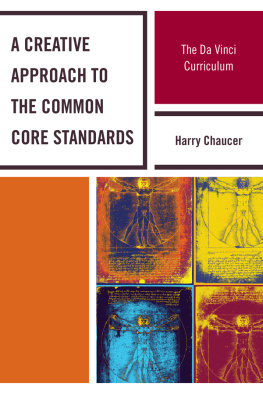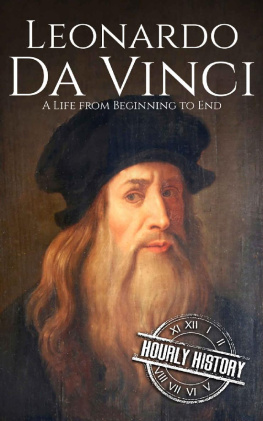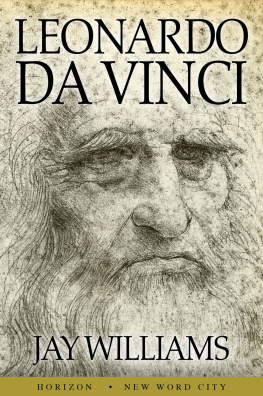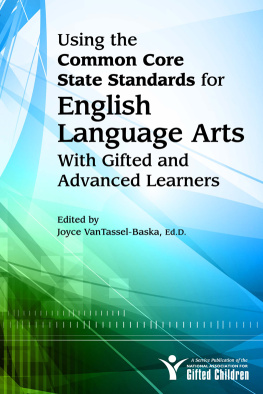Praise for A Creative Approach to the Common Core Standards: The Da Vinci Curriculum
In this book, Harry Chaucer has done for teaching what his Da Vinci Curriculum does for learning. He has found ways to engage students in discovering meaning while they also meet common standards and create personal understanding of their role in a democracy. He invites teachers to do the same, designing learning based on big questions that cross the boundaries of the disciplines in search of defensible answers. Under this principle, teaching and learning follow the pattern of inquiry rather than compliance with prescription. John H. Clarke, author of Patterns of Thinking and Personalizing the High School Experience
Weve always had standards in education and new standards alone wont transform our system. At best, they will make a better twentieth-century system. Chaucer is talking about a needed transformation of the system where learners confidently use what they know against what they do not know, and question storming guides the way ahead. This work will bring excitement back to the learner. Raymond J. McNulty, president, International Center for Leadership in Education
A visionary educator and innovator, Harry Chaucer has chosen exactly the right moment in American time to offer this important, potentially revolutionary call to arms in our at-risk educational system. Ron Powers, Pulitzer prizewinning author of Mark Twain: A Life ; coauthor of Flags of Our Fathers ; and collaborator on the late Edward M. Kennedys True Compass: A Memoir
A Creative Approach to the Common Core Standards
The Da Vinci Curriculum
Harry Chaucer
ROWMAN & LITTLEFIELD EDUCATION
A division of
Rowman & Littlefield Publishers, inc.
Lanham New York Toronto Plymouth, UK
Published by Rowman & Littlefield Education
A division of Rowman & Littlefield Publishers, Inc.
A wholly owned subsidiary of The Rowman & Littlefield Publishing Group, Inc.
4501 Forbes Boulevard, Suite 200, Lanham, Maryland 20706
www.rowman.com
10 Thornbury Road, Plymouth PL6 7PP, United Kingdom
Copyright 2012 by Harry Chaucer
All rights reserved. No part of this book may be reproduced in any form or by any electronic or mechanical means, including information storage and retrieval systems, without written permission from the publisher, except by a reviewer who may quote passages in a review.
British Library Cataloguing in Publication Information Available
Library of Congress Cataloging-in-Publication Data
Chaucer, Harry.
A creative approach to common core standards : the Da Vinci curriculum / Harry Chaucer.
p. cm.
Includes bibliographical references.
ISBN 978-1-61048-672-9 (cloth : alk. paper)ISBN 978-1-61048-673-6 (pbk. : alk. paper)ISBN 978-1-61048-674-3 (electronic)
1. Education, SecondaryCurriculaUnited States. 2. Education, SecondaryStandardsUnited States. 3. Curriculum changeUnited States. 4. School improvement programsUnited States. 5. Leonardo, da Vinci, 1452-1519. I. Title.
LB1628.5.C43 2012
373.190973dc23
2012000353
 The paper used in this publication meets the minimum requirements of American National Standard for Information SciencesPermanence of Paper for Printed Library Materials, ANSI/NISO Z39.48-1992.
The paper used in this publication meets the minimum requirements of American National Standard for Information SciencesPermanence of Paper for Printed Library Materials, ANSI/NISO Z39.48-1992.
Printed in the United States of America

Preface
How to Read This Book
This book is about the new Common Core State Standards and an intellectually vibrant seventhtwelfth grade core curriculum called the Da Vinci Curriculum. The Da Vinci Curriculum embraces the challenging new standards. The Da Vinci Curriculum (and its related instructional and assessment practices) is an example of biographical curriculacurricula stimulated from the life and work of admired historical figures and grounded in history.
I have written this book for educators looking for engaging secondary school models that embrace the new Common Core State Standards. Readers may be teachers (public, charter, or independent), change agents and school leaders, or education students at the undergraduate or graduate levelanyone interested in schools that are full of passionate inquiry.
This book calls for fundamental change in the secondary school curriculum. The author views the new standards as an opportunity to reexamine and radicallyfundamentallychange the curriculum. The Common Core calls for bold change, for standards that are robust and relevant to the real world.
This book presents an alternative in detail and builds a case for other schools to adapt similar practices, to create their own biographical curricula, or to create other bold alternatives to the twentieth-century high school curriculum. This books calls for nothing less than a renaissance in secondary education.
At the heart of this book are two simple premises: we human beings are wired for learning, and every single part of the universe is inherently fascinating. We are good at learning, and learning is intrinsically satisfying for us. Learning is our central purpose, and we are skillful learners. Millions of years of evolution and thousands of years of culture have tuned our brains to acquire knowledge, to create questions, and to imagine ideas. Most importantly, learning is deeply rewarding to us.
The Common Core is nothing more than sensible standards that guide us on our journey as teachers and as learners. This text is about the marriage of these standards with engaging curriculum that stimulates deep intellectual work, the kind of work that humans are uniquely good at when the lifeblood of learning is allowed to flow.
In the coming years, educators will have a choice. We may choose view the Common Core State Standards as something imposed by bureaucrats so that we can half-heartedly integrate the Common Core into our existing practices. If we do so, we will have missed an opportunity to fundamentally rethink the central intellectual purpose of learning. We will have released high school 1.1, a slight modification of high school 1.0, and an utter mismatch with student 2.0, the connected and concerned student of today.
In contrast, this text recommends that we embrace the Common Core and use it to create a renaissance in our thinking about school, learning, students, and the central purpose of adolescence. This is high school 2.0, a deep rethinking of what is meaningful intellectual work in the middle and high school years.
This is a book that arose from practice. The text has a strong theoretical base, but the practices described here have been tested over many years with real students, faculty, classrooms, books, and parents. This book comes from the classroom rather than the ivory tower.
The text advocates for curriculum that is rooted in the history of ideas and that has at its core a central organizing purpose. Leonardo da Vinci, a symbol of the Italian High Renaissance, embodies the central purpose in the core curriculum named the Da Vinci Curriculum.
After presenting the Common Core, chapters 2 through 9 present aspects of the Da Vinci Curriculum that reflect the wide-ranging inquiry of a person like Leonardo. Some chapters stress curriculum and its relationship to the Common Core (chapters 2, 3, and 57), and others emphasize instructional practices (chapters 4, 8, and 9 especially). Chapter 10 presents a summary of Leonardos life and suggests other men and women from whom biographical curriculum might be designed.
Chapter 11 examines other programs needed to address the learning needs of todays students and chapter 12 discusses briefly aspects of the change process in secondary schools.








 The paper used in this publication meets the minimum requirements of American National Standard for Information SciencesPermanence of Paper for Printed Library Materials, ANSI/NISO Z39.48-1992.
The paper used in this publication meets the minimum requirements of American National Standard for Information SciencesPermanence of Paper for Printed Library Materials, ANSI/NISO Z39.48-1992.